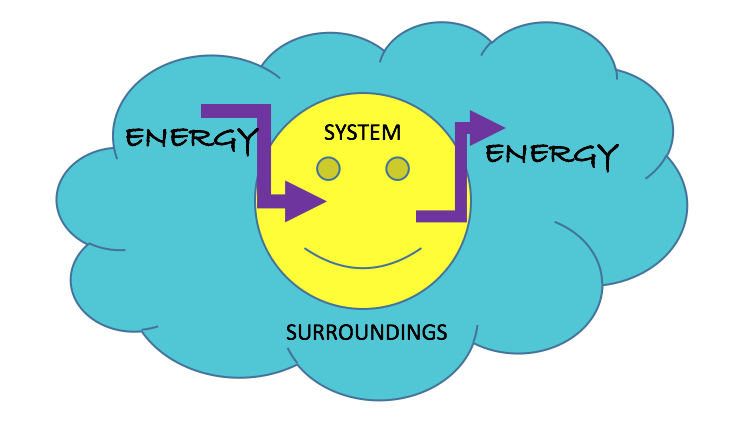System & Surroundings: Difference between revisions
Gnewville3 (talk | contribs) No edit summary |
Gnewville3 (talk | contribs) No edit summary |
||
| Line 6: | Line 6: | ||
''∆Esystem + ∆Esurroundings = 0'' | ''∆Esystem + ∆Esurroundings = 0'' | ||
This best shows the idea that since energy is a conserved quantity, systems may only gain/lose energy if the surroundings lose/gain that same amount. This can be pictured in the image below. | This best shows the idea that since energy is a conserved quantity, systems may only gain/lose energy if the surroundings lose/gain that same amount. This can be pictured in the image below. | ||
[[File:Image33333.png]] | |||
The | The Energy Principle can then be arranged by using the fact that the change in energy of a specific system is equal to the work done on the system by the surroundings. | ||
''∆Esystem = W'' | ''∆Esystem = W'' | ||
where ∆Esystem = Ef - Ei, making this equation now equal to: | where ∆Esystem = Ef - Ei, making this equation now equal to: | ||
| Line 14: | Line 14: | ||
==Choice of System== | ==Choice of System== | ||
Although physical results are always consistent, | Although physical results are always consistent, choosing different objects as the system changes the form of the energy equation that needs to be used, and which energy terms must be included in order to calculate accurate values for unknowns. In the following example, a fairly complex system will be analyzed in several different ways. Each of these will show a different choice of system and surroundings and how this effects the Energy Principle. | ||
===Example=== | |||
==External links== | ==External links== | ||
Revision as of 22:15, 19 April 2016
Introduction: System, Surroundings, and Energy Accounting
When it comes to energy, choosing what is the system versus what is the surroundings greatly affects what needs to be accounted for when solving for various values. Choosing certain objects to be apart of the system rather than the surroundings can have an extreme effect on the outcome of said variables, especially when the surroundings do a fairly large amount of work on the system. By definition, a system is a specific part of the universe that we choose to study, while the surroundings are everything else that 'surrounds,' and typically has a significant effect on, the system. This page will analyze how different choices of systems can affect the components of the Energy Principle when relating it to the system.
The Energy Principle
To first understand the impact of the choice of system, it is best to fully understand the Energy Principle. The Energy Principle is based off of the fact that energy is a conserved quantity, meaning that it cannot be created nor destroyed. This definition of the conservation of energy gives the equation:
∆Esystem + ∆Esurroundings = 0
This best shows the idea that since energy is a conserved quantity, systems may only gain/lose energy if the surroundings lose/gain that same amount. This can be pictured in the image below.

The Energy Principle can then be arranged by using the fact that the change in energy of a specific system is equal to the work done on the system by the surroundings.
∆Esystem = W
where ∆Esystem = Ef - Ei, making this equation now equal to:
Ef = Ei + W
The above equation will be what will primarily be used when accounting for all energy terms when the choice of system/surroundings changes.
Choice of System
Although physical results are always consistent, choosing different objects as the system changes the form of the energy equation that needs to be used, and which energy terms must be included in order to calculate accurate values for unknowns. In the following example, a fairly complex system will be analyzed in several different ways. Each of these will show a different choice of system and surroundings and how this effects the Energy Principle.
Example
External links
Thinking about Physics Thinking by Professor Michael Schatz [1]
References
Matter and Interactions 4th Edition
Thinking about Physics Thinking
--Gnewville3 (talk) 22:39, 19 April 2016 (EDT)